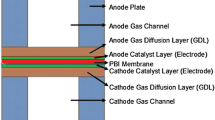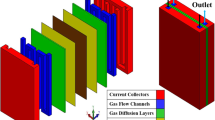Abstract
Conventional parallel cooling channels introduce some challenges that would reduce cooling channel performance. So, presenting novel ideas is to improve the cooling channel performance and determine which parameters play a vital role in this flow field. In this study, the thermal performance of a conventional polymer fuel cell (PEM) parallel cooling channel is investigated numerically by computational fluid dynamics and optimized by the Taguchi method. The study focuses on aluminum oxide in a distilled water/ethylene glycol (W/EG) mixture with a nanoparticles-volume concentration as the coolant in a fuel cell cooling channel. Since both thermal and hydraulic points of view are essential in cooling engineering, heat transfer and pressure drop were considered. For this reason, the Nusselt number was considered to evaluate convection heat transfer, and pressure drop was estimated to weigh flow behavior through the cooling channel. According to the results, heat transfer and pressure drop have augmented by about 20–78.1% as the fluid velocity picks up in the channel. Increasing the share of EG is another measure to improve the rates of heat transfer and pressure drop for 41.7% and 71%, respectively. As expected, the results will approve that a higher concentration of Al2O3 NPs enhances the pressure drop and heat transfer rate by about 92.59 and 6.75%, respectively. In addition, the Reynolds number and nanoparticle percentage were found as the most effective parameters for both heat transfer rate and pressure drop.








Similar content being viewed by others
Abbreviations
- \(c_{p}\) :
-
Heat capacity (W/kg.K)
- \(H\) :
-
Heat transfer coefficient (W/m2.K)
- \(L\) :
-
Channel length (mm)
- \(k\) :
-
Thermal conductivity coefficient (W/m.k)
- \(Nu\) :
-
Nusselt number (hd/k)
- \(m^{.}\) :
-
Mass flow rate (kg/s)
- \(p\) :
-
Pressure drops (N/m2)
- \({\text{Re}}\) :
-
Reynolds number
- \({\text{SN}}\) :
-
Signal to noise
- \(T\) :
-
Temperature (C)
- \(u\) :
-
Velocity (m/s)
- \(\rho\) :
-
Density (kg/ms)
- \(\mu\) :
-
Viscosity (kg/m3)
References
Japar WMAA, Sidik NAC, Saidur R, Asako Y, Yusof SNA (2020) A review of passive methods in microchannel heat sink application through advanced geometric structure and nanofluids: current advancements and challenges. Nanotechnol Rev 9(1):1192–1216
Wu W, Zhai C, Sui Z, Sui Y, Luo X (2021) Proton exchange membrane fuel cell integrated with microchannel membrane-based absorption cooling for hydrogen vehicles. Renew Energy 178:560–573
Trisaksri V, Wongwises S (2007) Critical review of heat transfer characteristics of nanofluids. Renew Sustain Energy Rev 11(3):512–523
Kumar R, Tiwary B, Singh PK (2022) Thermofluidic analysis of Al2O3-water nanofluid cooled branched wavy heat sink. Appl Therm Eng 201:117787
Li J, Peterson GP, Cheng P (2004) Three-dimensional analysis of heat transfer in a micro-heat sink with single phase flow. Int J Heat Mass Transf 47(19–20):4215–4231
Jamshidmofid M, Bahiraei M (2022) Thermohydraulic assessment of a novel hybrid nanofluid containing cobalt oxide-decorated reduced graphene oxide nanocomposite in a microchannel heat sink with sinusoidal cavities and rectangular ribs. Int Commun Heat Mass Transfer 131:105769
Wang J, Yu K, Ye M, Wang E, Wang W, Sundén B (2022) Effects of pin fins and vortex generators on thermal performance in a microchannel with Al2O3 nanofluids. Energy 239:122606
Azizi Z, Barzegarian R, Behvandi M (2022) Design-expert aided thermohydraulic assessment of a nanofluid-cooled cylindrical microchannel heat sink: possible application for thermal management of electric vehicle batteries. Sustain Energy Technol Assess 50:101876
AM Borbely JF Kreider (2001) Distributed generation: the power paradigm for the new millennium, CRC Press
Li Y, Taghizadeh-Hesary F (2022) The economic feasibility of green hydrogen and fuel cell electric vehicles for road transport in China. Energy Policy 160:112703
Kobayashi H, Hayakawa A, Somarathne KKA, Okafor EC (2019) Science and technology of ammonia combustion. Proc Combust Inst 37(1):109–133
Xu Q, Guo Z, Xia L, He Q, Li Z, Bello IT, Zheng K, Ni M (2022) A comprehensive review of solid oxide fuel cells operating on various promising alternative fuels. Energy Conv Manage 253:115175
Song Z, Pan Y, Chen H, Zhang T (2021) Effects of temperature on the performance of fuel cell hybrid electric vehicles: a review. Appl Energy 302:117572
Zhang Q, Harms C, Mitzel J, Gazdzicki P, Friedrich KA (2022) The challenges in reliable determination of degradation rates and lifetime in polymer electrolyte membrane fuel cells. Curr Opin Electrochem 31:100863
Zhao C, Xing S, Liu W, Chen M, Wang H (2021) Performance and thermal optimization of different length-width ratio for air-cooled open-cathode fuel cell. Renew Energy 178:1250–1260
Wang Y, Chen KS, Mishler J, Cho SC, Adroher XC (2011) A review of polymer electrolyte membrane fuel cells: technology, applications, and needs on fundamental research. Appl Energy 88(4):981–1007
Afshari E, Ziaei-Rad M, Dehkordi MM (2017) Numerical investigation on a novel zigzag-shaped flow channel design for cooling plates of PEM fuel cells. J Energy Inst 90(5):752–763
Rahgoshay SM, Ranjbar AA, Ramiar A, Alizadeh E (2017) Thermal investigation of a PEM fuel cell with cooling flow field. Energy 134:61–73
Ghasemi M, Ramiar A, Ranjbar AA, Rahgoshay SM (2017) A numerical study on thermal analysis and cooling flow fields effect on PEMFC performance. Int J Hydrog Energy 42(38):24319–24337
Bargal MH, Abdelkareem MA, Tao Q, Li J, Shi J, Wang Y (2020) Liquid cooling techniques in proton exchange membrane fuel cell stacks: a detailed survey. Alex Eng J 59(2):635–655
Choi J, Kim YH, Lee Y, Lee KJ, Kim Y (2008) Numerical analysis on the performance of cooling plates in a PEFC. J Mech Sci Technol 22(7):1417–1425
Chen FC, Gao Z, Loutfy RO, Hecht MJFC (2003) Analysis of optimal heat transfer in a PEM fuel cell cooling plate. Fuel Cells 3(4):181–188
Nam JH, Lee KJ, Sohn S, Kim CJ (2009) Multi-pass serpentine flow-fields to enhance under-rib convection in polymer electrolyte membrane fuel cells: design and geometrical characterization. J Power Sources 188(1):14–23
Yu SH, Sohn S, Nam JH, Kim CJ (2009) Numerical study to examine the performance of multi-pass serpentine flow-fields for cooling plates in polymer electrolyte membrane fuel cells. J Power Sour 194(2):697–703
Shang, D. Y. (2010). Theory of heat transfer with forced convection film flows. Springer Science & Business Media.
Garrity PT, Klausner JF, Mei R (2007) A flow boiling microchannel evaporator plate for fuel cell thermal management. Heat Transfer Eng 28(10):877–884
Ahmed, S. S., Ghyadh, N. A., & Al-Baghdadi, M. A. S. (2021). Cfd investigation of flow and heat transfer enhancement in cross flow microchannel heat exchanger using nanofluid
Islam MR, Shabani B, Rosengarten G, Andrews J (2015) The potential of using nanofluids in PEM fuel cell cooling systems: a review. Renew Sustain Energy Rev 48:523–539
Islam MR, Shabani B, Rosengarten G (2016) Nanofluids to improve the performance of PEM fuel cell cooling systems: a theoretical approach. Appl Energy 178:660–671
Zakaria I, Azmi WH, Mamat AMI, Mamat R, Saidur R, Talib SA, Mohamed WANW (2016) Thermal analysis of Al2O3–water ethylene glycol mixture nanofluid for single PEM fuel cell cooling plate: an experimental study. Int J Hydrog Energy 41(9):5096–5112
Zakaria I, Mohamed WANW, Azmi WH, Mamat AMI, Mamat R, Daud WRW (2018) Thermo-electrical performance of PEM fuel cell using Al2O3 nanofluids. Int J Heat Mass Transf 119:460–471
Ramezanizadeh M, Nazari MA, Ahmadi MH, Chen L (2019) A review on the approaches applied for cooling fuel cells. Int J Heat Mass Transf 139:517–525
Zakaria IA, Mohamed WANW, Zailan MB, Azmi WH (2019) Experimental analysis of SiO2-distilled water nanofluids in a polymer electrolyte membrane fuel cell parallel channel cooling plate. Int J Hydrog Energy 44(47):25850–25862
Chahartaghi M, Kharkeshi BA (2018) Performance analysis of a combined cooling, heating and power system with PEM fuel cell as a prime mover. Appl Therm Eng 128:805–817
van las Heras A, Vivas FJ, Segura F, Redondo MJ, Andújar JM (2018) Air-cooled fuel cells: keys to design and build the oxidant/cooling system. Renew Energy 125:1–20
Guk E, Venkatesan V, Babar S, Jackson L, Kim JS (2019) Parameters and their impacts on the temperature distribution and thermal gradient of solid oxide fuel cell. Appl Energy 241:164–173
Li S, Sundén B (2018) Numerical study on thermal performance of non-uniform flow channel designs for cooling plates of PEM fuel cells. Numer Heat Transfer Part A: Appl 74(1):917–930
FP Incropera, DP DeWitt, TL Bergman, AS Lavine (1996). Fundamentals of heat and mass transfer ,Vol. 6, p. 116. New York, Wiley
Morini GL (2004) Laminar-to-turbulent flow transition in microchannels. Microscale Thermophys Eng 8(1):15–30
Tansley CE, Marshall DP (2001) Flow past a cylinder on a β plane, with application to Gulf stream separation and the antarctic circumpolar current. J Phys Oceanogr 31(11):3274–3283
Levin MLV, Miller MAF (1981) Maxwell’s” treatise on electricity and magnetism". Sov Phys Uspekhi 24(11):904
Masuda H, Ebata A, Teramae K (1993) Alteration of thermal conductivity and viscosity of liquid by dispersing ultra-fine particles. Dispersion of Al2O3, SiO2 and TiO2 ultra-fine particles. Mater Sci. https://doi.org/10.2963/JJTP.7.227
SU Choi, & JA Eastman (1995). Enhancing thermal conductivity of fluids with nanoparticles (No. ANL/MSD/CP-84938; CONF-951135–29). Argonne National Lab. (ANL), Argonne, IL (United States).
Sundar LS, Ramana EV, Singh MK, Sousa AC (2014) Thermal conductivity and viscosity of stabilized ethylene glycol and water mixture Al2O3 nanofluids for heat transfer applications: an experimental study. Int Commun Heat Mass Transfer 56:86–95
Murshed SMS, Leong KC, Yang C (2005) Enhanced thermal conductivity of TiO2—water based nanofluids. Int J Therm Sci 44(4):367–373
Ghasemi B, Aminossadati SM (2009) Natural convection heat transfer in an inclined enclosure filled with a water-CuO nanofluid. Numer Heat Transfer Part A: Appl 55(8):807–823
Etghani MM, Hosseini Baboli SA (2017) Numerical investigation and optimization of heat transfer and exergy loss in shell and helical tube heat exchanger. Appl Therm Eng 121:294–301
Seyedi I, Maleki-Daronkolaei A (2013) Solving a two-stage assembly flow shop scheduling problem to minimize the mean tardiness and earliness penalties by three meta-heuristics. Casp J Appl Sci Res 2(4):67–78
Rana P, Gupta G (2022) Heat transfer optimization of Marangoni convective flow of nanofluid over an infinite disk with Stefan blowing and slip effects using Taguchi method. Int Commun Heat Mass Transfer 130:105822
Funding
There has been no significant financial support for this work that could have influenced its outcome.
Author information
Authors and Affiliations
Contributions
We understand that the Corresponding Author is the sole contact for the Editorial process (including Editorial Manager and direct communications with the office). SAHB is responsible for communicating with the other authors about progress, submissions of revisions and final approval of proofs. We confirm that we have provided a current, correct email address which is accessible by the Corresponding Author.
Corresponding author
Ethics declarations
Conflict of interest
We wish to confirm that there are no known conflicts of interest associated with this publication.
Ethical approval
We confirm that the manuscript has been read and approved by all named authors and that there are no other persons who satisfied the criteria for authorship but are not listed. We further confirm that the order of authors listed in the manuscript has been approved by all of us. We confirm that we have given due consideration to the protection of intellectual property associated with this work and that there are no impediments to publication, including the timing of publication, with respect to intellectual property.
Additional information
Technical Editor: Jader Barbosa Jr.
Publisher's Note
Springer Nature remains neutral with regard to jurisdictional claims in published maps and institutional affiliations.
Rights and permissions
Springer Nature or its licensor (e.g. a society or other partner) holds exclusive rights to this article under a publishing agreement with the author(s) or other rightsholder(s); author self-archiving of the accepted manuscript version of this article is solely governed by the terms of such publishing agreement and applicable law.
About this article
Cite this article
Hosseini Baboli, S.A., Arabkoohsar, A. & Seyedi, I. Numerical modeling and optimization of pressure drop and heat transfer rate in a polymer fuel cell parallel cooling channel. J Braz. Soc. Mech. Sci. Eng. 45, 201 (2023). https://doi.org/10.1007/s40430-023-04106-z
Received:
Accepted:
Published:
DOI: https://doi.org/10.1007/s40430-023-04106-z




